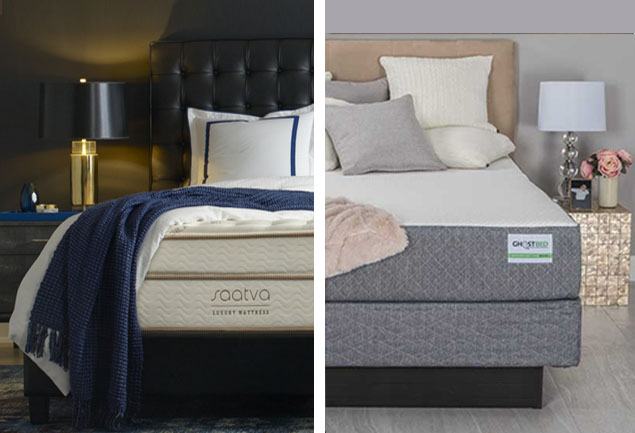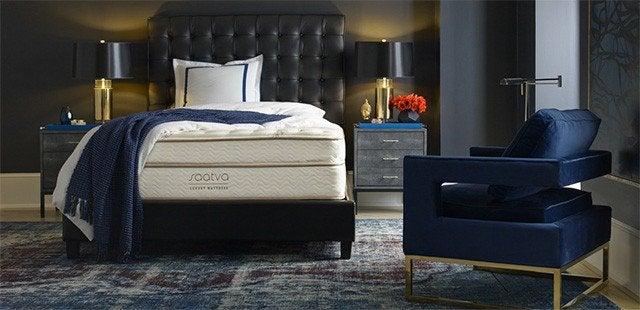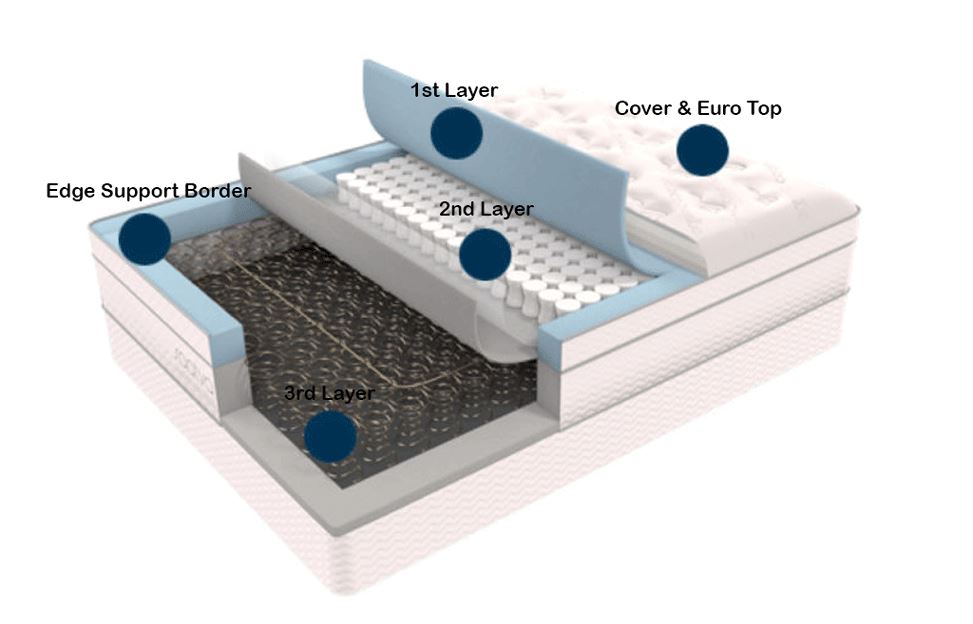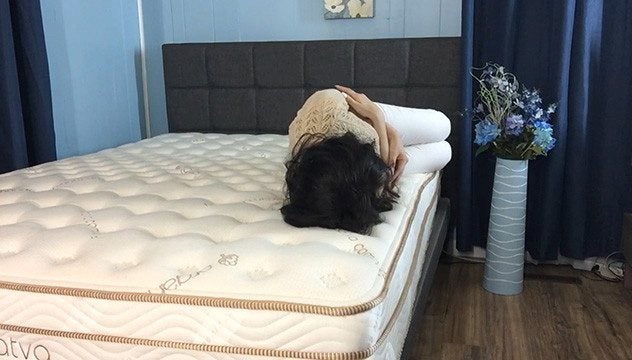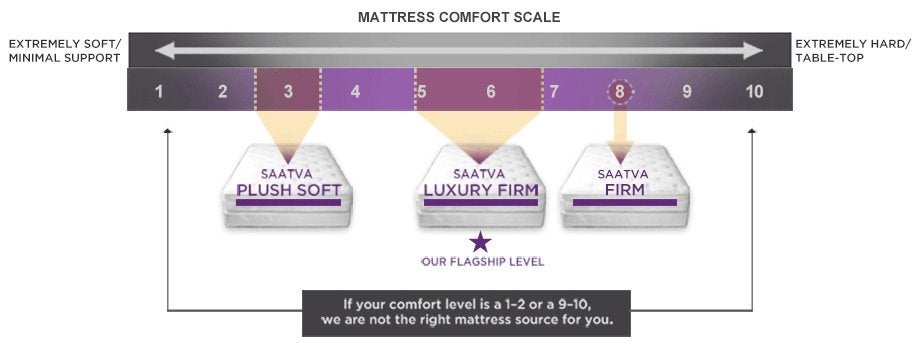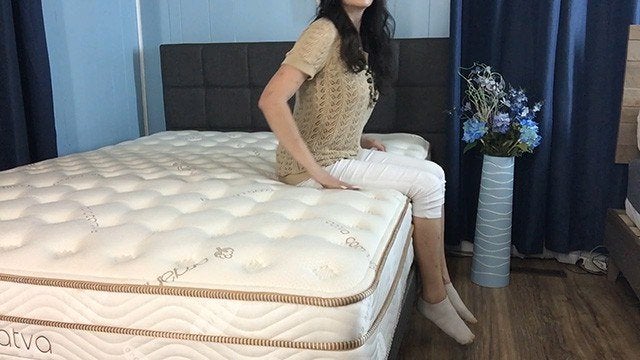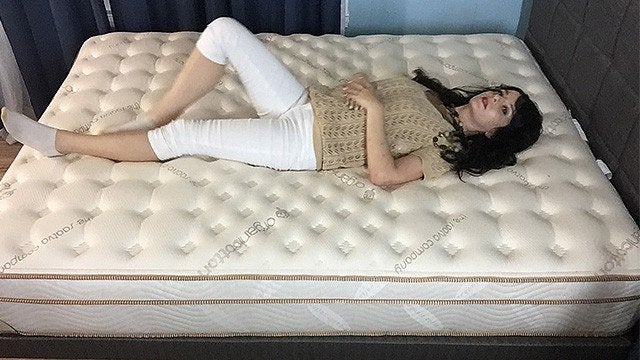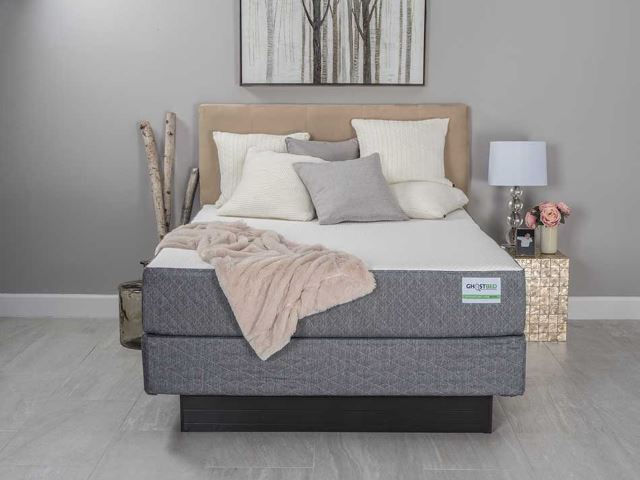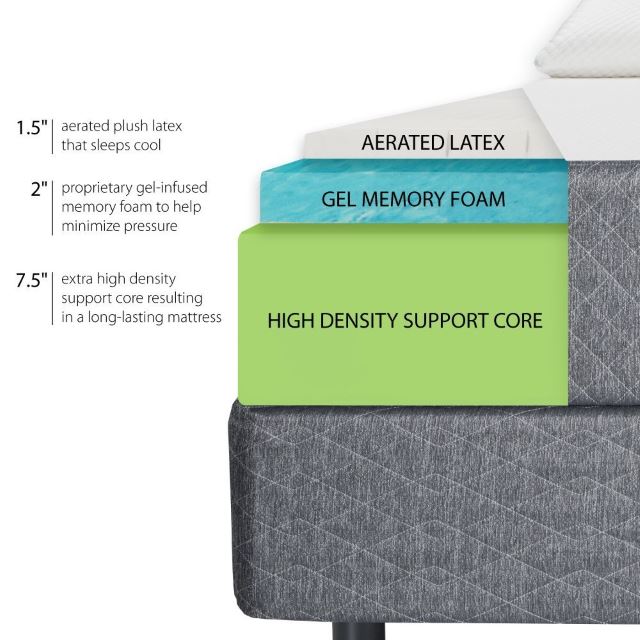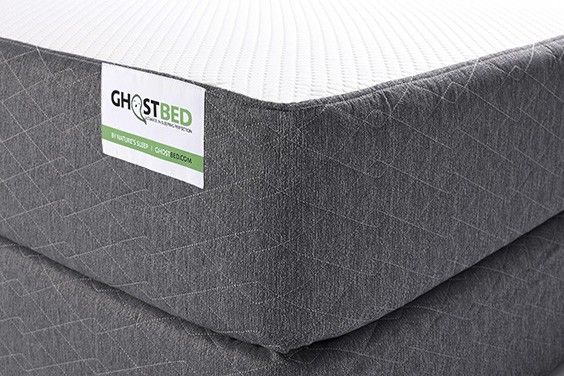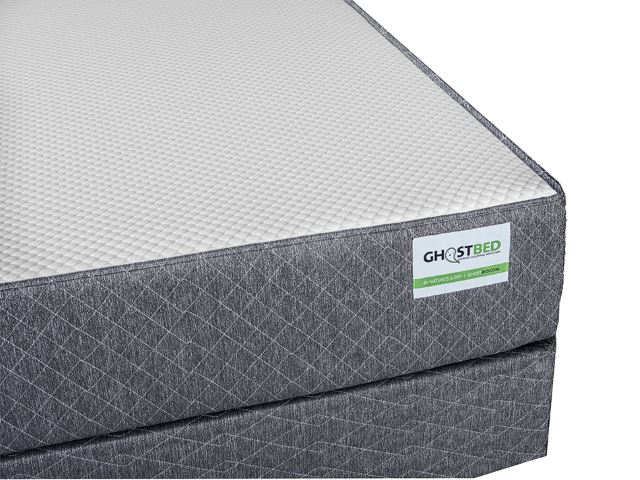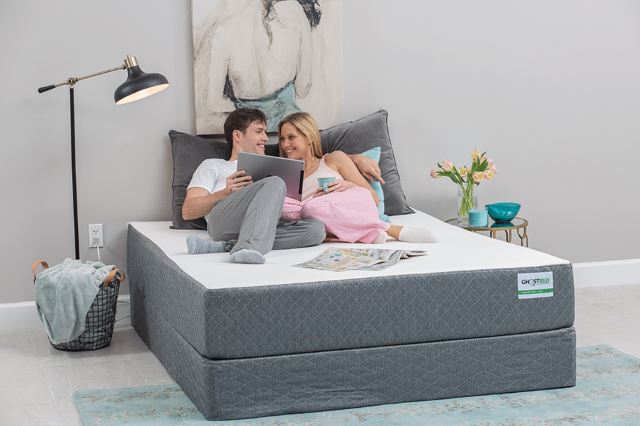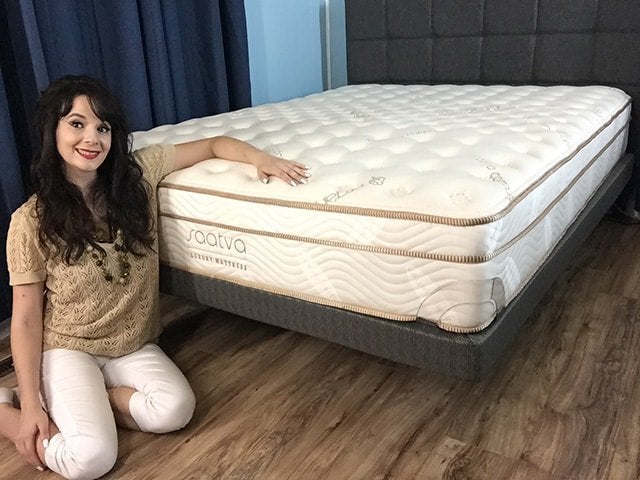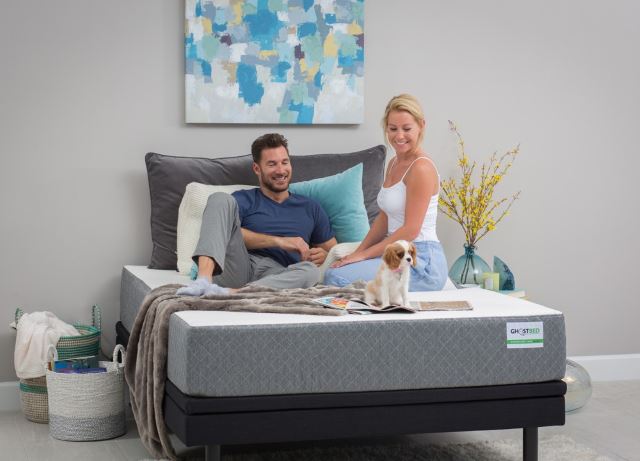Hybrid mattresses have then taken the market by storm because of how they combine the good properties of different materials into a single product that provides a unique blend of comfort and support. Manufacturers have rightly recognized that a homogenous construction, say a memory foam alone or spring coils alone, is not enough to give their consumers the most relaxing, pressure relieving sleep possible.
As a result, we have high-end memory foam/innerspring hybrids, memory foam/latex foam hybrids, and the like wherein the mattress maker tries to combine cushioning with resilience to bring us the best of both worlds. Saatva is a prime example of the viscoelastic/spring formula, whereas the Ghostbed Classic is a superb testament to the viscoelastic/latex combination.
I think a Saatva vs Ghostbed comparison is in order to give you an idea of which path to choose on your own sleep journey, given that these hybrid combinations are probably two of the most popular ones, today.
Saatva Breakdown
The Saatva is a hybrid memory foam/spring mattress that tries to combine a classical steel coil construction with a controlled amount of viscoelastic to soften the spring a bit.
Construction
Cover
A cover made completely from pure organic cotton adorns the Saatva, giving it a soft, sleek, and traditional feel and look that you can detect the moment you rest your head on the mattress. Cotton is inherently breathable, which means that the surface of the mattress stays cool as you sleep.
Euro top
The manufacturer has placed a 1.25-inch thick Euro pillow top underneath the cover to give the sleeper an immediate cushioning effect when they lay on the bed. The pillow top is comprised of thick memory foam to allow it to adapt to your profile.
Equally impressively, the Euro top is snugly fit over all of the layers, making for a luxurious and attractive design.
First Layer
This is the first actual layer of the mattress – 3/8 inches of viscoelastic foam to soften the pushback produced by the coil-on-coil structure underneath. In conjunction with the Euro top, it adapts to the shape of your body to offer pressure relief upon impact.
The layer is kept so thin on purpose so that it does its job without interfering with the springy response that makes up the hallmark of the mattress.
Second Layer
The next layer is made from 4-inches long, 14-gauge pocketed coils – each of these coils is designed to react to pressure locally, independent from its neighbors, so that the layer as a whole is able to adjust itself to your sleep style – something that is impossible with traditional interconnected steel springs.
The individual action of these coils prevents the transmission of sudden impacts to the surrounding parts of the mattress as well. Moreover, an encasement of edge support foam makes sure that these springs don’t sink at the sides over much when you put your weight at the edge of the bed.
Third Layer
Up next, there is another steel coil layer – but in this case, the springs are interlinked and are longer (5.5”) and thicker (13-gauge). The reason behind this is to enable this layer to serve a supportive role – it holds up your body mass in correct alignment after the aforementioned layers have relieved the initial pressure by molding themselves to your profile.
Edge Support Boundary
The mattress is surrounded by a tough boundary – the purpose is to provide targeted edge support (as if the coil-on-coil structure itself and the edge support encasement of the pocketed coils weren’t enough!).
Firmness and Feel
The Saatva is available in three levels of firmness, each of emphasizes the softness of the upper layers and the supportiveness of the coils in different proportions.
Comfort and Support
- Plush – The softest variant of the Saatva has a net ILD rating of 18 – in line with a medium soft level of firmness. The manufacturer has their own firmness scale too, though: 0 is softest, 10 is hardest – on this relative scale, the Plush Saatva is rated at 3.The Plush model is as plush as you can get with an innerspring mattress, i.e. it has the greatest amount of contouring and the least stiffness in the springs that is possible without the Saatva losing a significant portion of its essence.
- Luxury Firm – The Luxury Firm variant is the most popular with consumers, which makes sense since it creates an even proportion between comfort and support by making the plush memory foam upper layers equally effective as the underlying spring layers.Only Saatva knows the actual ILD rating of the mattress because, as a result of the widespread appeal it enjoys in the market, they have decided to keep the value a secret to prevent imitation. Nonetheless, they’ve rated it on their own scale: 5-7.
- Firm – The Firm model focuses the most on the steel coil structure that forms the core of the mattress. Of course, it doesn’t completely suppress the contouring behavior of the memory foam – it just tunes it down to the point that it offers minimal adaptability, so the sleeper can enjoy stiff, resilient support characteristic of a true innerspring mattress.
Edge Support
The edge support foam that encases the upper pocketed coils in conjunction with the dedicated edge support boundary incorporated into the Saatva ensures that the mattress does not sink at the edges when pressure is applied. Indeed, even without these features, the stiffness of the springs alone may have been sufficient in most cases, but with them, there is no chance of you sliding down the side of the bed while sitting there!
Cooling
The coil-on-coil design of the Saatva allows for plenty of airflow so that the heat accumulated by the memory foam is removed effectively. In turn, the typical heating problems with the material are avoided for the most part. The breathable cotton cover also plays a role, rapidly transferring the heat from the surface onto the lower layers.
That said, the memory foam still retains some heat over time, which is why the Saatva’s breathability is slightly less than the average. Nonetheless, I would expect it to be more breathable compared to the all-foam Ghostbed (despite the latter being more breathable than average compared to its direct competition).
Motion Transfer
The upper viscoelastic layers of the Saatva are able to muffle out most impacts in conjunction with a relatively pliable response of the pocketed coils. Thus, you won’t disturb your partner (and vice versa) due to movements in your sleep, which is not the norm for traditional innersprings where the smallest movements can be felt across the bed.
Unique Features
Mixture of springy support and viscoelastic conformity
By combining dual spring layers with small layers of memory foam, the Saatva exhibits the qualities of both materials – the springs give it resilient support (the pocketed coils actually contribute to conformity too), whereas the memory foam lets the mattress contour to your body the moment you rest yourself on the bed.
Consequently, the Saatva performs better than it would have done with either material alone. Of course, the exact ratio in which the two elements are present in the mattress depends on the firmness variant you choose.
Euro pillow top
The Euro top that is a part of the Saatva gives it an undeniably high-end appeal that is characteristic of beds found in luxury hotel rooms. More importantly, it adds to the surface comfort of the bed and relaxes your stiff muscles instantaneously.
The Ghostbed may have latex and memory foam for comfort and pressure relief, but neither can convey their functionality with the kind of lavishness that is possible with a Euro top.
Superb edge support
The multiple edge support enhancement features of the Saatva (and the fact that it has a steel skeleton) mean that the edge support of the mattress is a lot better than the all-foam construction of the Ghostbed. This is to be expected though – the latter contains a significant amount of memory foam which is meant to sink under pressure, and the overlying latex layer can only counter this so much.
Longer Trial Period
The Saatva’s trial period is of 120 days, compared to the 101-day trial of the Ghostbed. This may not seem like much of a difference, but if you consider it, there are 19 extra days to try the mattress out to see if it is worth the investment or not.
Cotton Cover
Most of us tend not to fret overmuch about the cover of the mattress we sleep on, but the Saatva’s pure organic cotton cover imbues classical, elegant luxury and softness so well that it deserves a mention of its own – especially when the competition uses synthetic fabrics that may be more economical but are unable come in par with timeless class of the Saatva cover.
You may want to check out: Saatva HD Coupon
Ghostbed Breakdown
The Ghostbed Classic is an all-foam hybrid mattress, sporting a rather unorthodox construction that combines memory foam with latex.
Construction
Cover
The cover is plush, crafted from polyester and viscose, as well as incorporating Micron to encourage moisture absorbency – thereby yielding a cool surface for you to sleep on overnight. The cover is well-fit over the actual layers of the mattress, lending the Ghostbed Classic a sleek, appealing look.
First Layer
This is the unusual part about the mattress – where most manufacturers tend to place memory foam on top of latex to yield an initial contouring feel, Ghostbed instead puts the latex layer on top. One-and-a-half inches of 3.5 lbs continuously aerated latex yields a bouncy and responsive pressure relief, which is quite different from the sticky, ‘enveloping’ response of memory foam.
I should point out here that nowhere has the manufacturer stated that this is pure natural latex foam, but judging from the fact that it does stay quite cool, it is at the very least a blend of synthetic and natural latex where the latter dominates.
Second Layer
Two inches of 4 lbs gel memory foam make up this next layer. Once the upper latex layer has absorbed the immediate impact, this layer provides you with deeper pressure relief by adapting the overall profile of the bed according to your posture.
Besides the gel infusion designed to absorb heat, the viscoelastic foam in this layer also has larger cells which are more reactive to your body heat so that the layer as a whole does not develop a permanent indentation under your weight which envelops you and makes you feel hot.
Third Layer
The support layer is comprised of 7.5 inches of 2 lbs of HD polyurethane foam. This layer is responsible for providing the push-back against your body weight to ensure that you sleep in the right spinal alignment throughout the night. Judging from its density, the support core should last you for many years.
Firmness and Feel
The Ghostbed is available in just a single firmness level – medium firm.
Comfort and Support
The medium firm response of the mattress is a result of the combination of latex, memory, and HD polyfoam. The latex and memory foam provide the cushioning, whereas the polyurethane foam provides the stiff supportiveness needed to ensure a correct posture.
It should be noted that while the manufacturer rates the Ghostbed at 6.5, which can be interpreted as medium-firm in theory, my observation regarding that mattress is that it is a bit more firm than what would normally be expected from such a rating. Perhaps this has to do with the fact that the latex is present above the memory foam and takes a longer time to break in than the latter.
Edge Support
As a result of the slightly resilient behavior of the latex foam, and the stiff support afforded by the HD polyfoam core, the edge support of the Ghostbed is quite decent – you won’t experience a lot of sinkage while sitting on the edge. Of course, the intermediate memory foam layer does introduce some give, but it isn’t unpleasant.
That said, the sturdy coil-on-coil construction of the Saatva is markedly better than what the Ghostbed brings to the table.
Motion Transfer
While the uppermost latex layer does introduce a slight amount of bounce in the mattress, the motion isolation is still up to the par because of the underlying viscoelastic which absorbs major impacts effectively. Even the slight residual motion that escapes it as a result of the latex is barely noticeable, and in exchange, you get lots of responsiveness in the mattress so that it is quickly able to adapt to changes in your posture- something that viscoelastic alone cannot achieve.
Cooling
The moisture absorbent cover and the aerated latex layer create ample ventilation to transfer heat away from your body and into the surroundings, and since the memory foam contains gel, it is able to absorb anything that isn’t dissipated into the surroundings.
The overall result is a mattress that is completely made from foam but quite surprisingly, is cool and breathable. On a related note, the memory foam has a large-celled molecular structure, and it is more reactive and doesn’t create a boulder under you, so you won’t feel suffocated by the mattress either.
You might want to read: GhostBed Sheet Set Review
Unique Features
All foam construction
Compared to the Saatva, where dual spring layers dominate the structure, the Ghostbed has an all-foam construction. Admittedly, there are three different kinds of foam in its construction, but the response as a whole is more inclined towards soft bounciness as opposed to stiff springiness in the case of the former.
Unusual latex on viscoelastic construction
As mentioned before, most manufacturers tend to put memory foam in the comfort layer (because of its soft, adaptive nature) and latex in the intermediate or support layer, but this is reversed in the case of the Ghostbed Classic as its maker wants to create a more reactive response, which, despite being conforming to your posture, is quick to regain its original shape as the pressure is removed.
As a result of this, several users have reported the Ghostbed to be firmer than most comparable products – but I suspect this to be a matter of longer break-in time, which latex is known for. In any case, with the Ghostbed, you get a mattress that is initially reactive but offers deep conformity and support.
Quite affordable
The Ghostbed, at its default price, is a hundred dollars cheaper than the Saatva – and when you consider the exceptionally generous discount, it becomes a solid bargain, especially given the quality of foams used in its construction and the multiple cooling mechanisms embedded in it. It is rare to find an all-foam mattress that offers this kind of value at the price it asks.
Longer warranty
The Ghostbed has a 20-year warranty, which is 5 years more than the Saatva’s 15 years. Without taking anything away from the Saatva (as beyond 10 years, warranties don’t matter much anyways in my opinion), the longer policy of the Ghostbed could be taken as a sign of the manufacturer’s confidence in the durability of their product.
When considered in conjunction with the low price point and the highly dense foam used in its construction, this longer warranty seems quite plausible.
Which One To Get?
Saatva
You may want to choose the Saatva if:
- You want resilience and contouring in the same package: The dual spring core of the mattress produces the stiff resilience you would expect from a true innerspring – however, this is tempered with the contouring ability of the pocketed coils and the memory foam up top.
The result is a modernized innerspring hybrid for sleepers who are tired of stiff spring mattresses that force them to sleep in an awkward posture. If you’re part of this consumer segment, you will want to go with the Saatva.
- You want to sleep on a Euro top: A Euro pillow top adds soft surface cushioning in a mattress and in an obvious yet aesthetically appealing way at that – if you’ve ever slept on a mattress that had one in a hotel and want something similar at home, the Saatva is the clear winner between the two.
- An organic cover is important: While the synthetic cover of the Ghostbed is CertiPUR-US certified (and thus completely safe from an environmental standpoint), some might still feel more comfortable sleeping on a mattress whose cover is made from natural materials. In this case, the Saatva’s organic cotton cover makes it the obviously superior choice.
- You seek edge support for your bed: The Saatva has excellent edge support for multiple reasons already detailed above. On the other hand, the Ghostbed’s edge support is passable at best. If you expect to be sitting on the edge of your bed for extended periods of time (e.g. to read to your child or look after a patient), the Saatva could prove more useful.
- You want more time to try the mattress out: The Saatva has 19 more days on its money-back-guarantee than the Ghostbed. For those who are undecided on whether they want a new, expensive mattress or not, this may prove enough of a window to sway their decision either way. If you’re in this boat, it is evident that going with the Saatva makes more sense.
You want more firmness options to consider: The Saatva has three firmness levels whereas the Ghostbed has but one – and that too is slightly stiffer than most medium-firm offerings. If you’ve got specific sleep needs that compel you to sleep on a different firmness level (being lightweight, being heavyweight, being a side sleeper, and so on), the Saatva has a higher chance of being closer to what you require.
Ghostbed
On the other hand, here are a few reasons to go for the Ghostbed instead of the Saatva:
- You’re on a budget: As already stated above, the Ghostbed is significantly less expensive than the Saatva once you consider the discounted price. Nonetheless, the materials used are of premium quality, and the mattress is breathable to boot. It doesn’t get much better in an all-foam mattress in this price range, so if you’re bound by a strict budget yet still want a reasonably luxurious mattress, the Ghostbed is worth consideration.
- You prefer an all-foam mattress over an innerspring one: If you’re one of those individuals who doesn’t like to feel the pressure of steel coils on your back (not that the Saatva makes it especially noticeable), the all-foam Ghostbed is definitely the better choice.
It may take a while for you to break into it (particularly if you’re a bit underweight). But once you do, it will be more pliable because of the combined action of the latex and the viscoelastic.
- A longer warranty matters to you: The Ghostbed’s longer warranty in comparison to the Saatva may be interpreted as a mark of the product’s superior durability. Personally, I wouldn’t give it much importance when the actual comparison is between 20 and 15 years respectively, but if you disagree and think that a more extensive warranty policy is significant, then Ghostbed is the obvious better choice.
I hope this comparison between two different kinds of modern hybrid mattresses increased your knowledge on the subject (perhaps even helps you choose a great mattress for your bedroom too). If you feel that it could help one of your friends or family members, please share it with them too. As always, do remember to leave your feedback and queries in the comments section below.
Saatva vs Ghostbed Comparison
| Saatva | Ghostbed | |
|---|---|---|
| Layers Used |
|
|
| Height | 11.5 inches / 14.5 inches | 10 inches |
| Firmness | Soft, Medium-Firm, Firm | Medium-Firm |
| Motion Transfer | Minimal | Minimal |
| Breathability | Slightly below average (for an innerspring product) | Slightly higher than average (for an all-foam product) |
| Trial Period | 180-day | 101-nights |
| Warranty | 15-year non-prorated | 20 years |
| Pricing (Queen) | $1,199 | $895 (currently discounted to $695) |
| Shipping | Free across the US | Free across the US |
| Discount | None at present | n/a |
